

Prestigious foreign publications, individuals, associations and international organizations have castigated the actions committed by Turkey and her military forces in Cyprus. It is perhaps not necessary to have the victim's testimony in order to describe the the crime that continues to be perpetrated under the passive eyes of Europe and of humanity. Nevertheless, what takes place constitutes a challenge for the European and universal principles and there is urgent need for reaction to the gradual but systematic wiping out of the cultural heritage of Cyprus, which has a universal character.
"Since then the Turkish side has been pursuing total separation of the communities. Last year all ethnic Turks were allowed to go north in exchange promises that the ethnic Greeks in the Turkish area would he given freer movement, better schools, and more medical care. In addition the Turkish side promised to allow the United Nations to set up posts in the north and provide the Greeks with moral and material support.
The Turkish side keeping few of its promises persisted in putting pressure on the remaining ethnic Creeks to leave. As a result a steady trickle of departures has become a flood. About 30 Greeks go south every day".
Steven V. Roberts, "The New York Times'' 1.11.1976.
The Turkish invasion of Cyprus and the policy pursued since
then by the governments in Ankara reveal the new face of
expansionism: Unlike the Ottoman Empire, the Turkish Republic
does not tolerate the existence of any other population in territory
which it occupies or controls. The bitter experiences of Asia Minor
minorities, were relieved with the same intensity by the Greek
population of the areas of Cyprus into which the Turkish army
entered in 1974. About 200,000 Greek Cypriots were forced to
seek refuge in the southern part of the island, the atrocities, rapes
cold-blooded murders Turkish troops committed and in general the
brutality shown by the Turkish troops forced the population to seek
refuge outside the occupied areas.
The first target of Turkish policy was achieved with the first and second invasion, on July 20 and August 14 respectively. The two communities of Cyprus were segregated geographically and a region was created from which the bearers of Greek civilization that is the population, had been ousted in their majority. Some thousands of Greeks, however, who wished to remain in their ancestral homes, stayed behind.
Life under Turkish occupation is not easy. From the first day onwards an intimidation and terror campaign is being implemented by the Turkish troops against the Greek population in the occupied territory. It becomes apparent that staying on in the ancestral homes implies harsh living conditions, restrictions and prohibitions, lack of security both for the life and the properties of the Greeks.
Greeks daily seek refuge in the free areas of the Republic from occupied Cyprus. Their flight, according to the conqueror, is 'voluntary'. Today only 570 Greeks and 250 Maronites reside under Turkish occupation. Their moral stamina resists the oppression of Ankara's army.
''Cyprus - A Bitter Lemon Squeezed Dry''
"Bellapais the Creek Cypriot village made famous by Lawrence Durrell's "Bitter Lemons" is no longer Creek. Two weeks ago its last seven Creek inhabitants gave up the struggle against the Turkish squeeze. With their departure the number of Creek Cypriots in the entire Kyrenia district of northern Cyprus is now fewer than 30. Because of this the Turkish authorities say that the United Nations force in Cyprus no longer needs a post in that area ".
The Economist 4.9 1976.
With the flight of the Greek population, Turkey succeeded in her first target: the region ceased to live and breathe to the tune to which it had done for almost three millenia of its history.
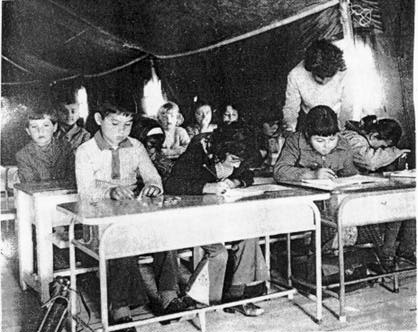
These insistent witnesses to the civilization of Cyprus always became a target of the conquerors and especially the Turks. They were destroyed during the Ottoman rule, became objects of illicit trade and smuggling within the areas controlled between 1963 and 1974 by Turkish Cypriot extremists. Today, though, after the Turkish invasion and occupation of the whole of the northern part of Cyprus, with the chasing out of nearly all the Greek inhabitants and with the importation of colonist settlers from Anatolia, the dangers appear more direct and much greater. The heritage of the island is being plundered, destroyed. It becomes the object of trade - offs on an unprecedented scale and pace.
The effort of the conquerors is continuous, systematic and multifaceted; the target is evident: to alter the character of the occupied part and to Turkify it completely.
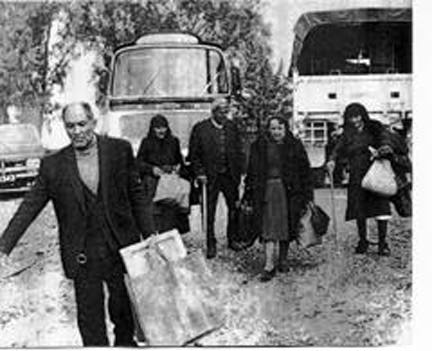
"Then we had a visit from two Turkish Cypriots on November 8. They were originally from Kokkina (a Turkish Cypriot village still under the control of the Greek Cypriot Government) and they said we had 15 days to leave. They said they had been told that they could have our house and that he authorities had sent them round to u.s.
I did not believe this was true and said: "You cannot tell us to leave. What authority have you got?" So the taller man held up a piece of paper with a Turkish stamp on it which gave his name as Hasum Mehmet and listed our house as 'F55'. In Yaloussa, the village was so small that we never had street numbers but this was the Turkish designation for our home. I told the men to leave and they did.
But next day a Turkish girl who lived two houses away and who was a friend of mine came to our home. She said that the Turks were going to burn my husband's lorry unless we agreed to leave immediately.
On the same day Mr Mehmed came back. He said he could bring some boxes for us if we needed extra packing cases when we moved. Then he asked my husband to show him how the water-heater worked in our bathroom".
Robert Fisk, The Times, 9.12.76.
In order to make the realization of the Conqueror's aims
possible, a plan was put into effect that strikes at every living and
non-living form of the civilization which flourished for millenia in
Cyprus. The Turkish troops and the Turkish Cypriot leaders turn
against people, churches, schools, antiquities and every form of
historical or cultural evidence.

''Cyprus treasures at risk''
(letter to the editor)
''The report (August 9)from the Cyprus Director of Antiquities on the recent looting or desecration of the mosaics in the church of Panayia Kanakaria in the Turkish occupied north of Cyprus has reopened the debate on the fate of churches, monasteries and mosques on that unhappy island.
As a journalist I have traveled widely and freely on both sides of the partition line. In Turkish Cyprus there was large scale damage to churches in the immediate aftermath of the 1974 intervention. That was perhaps understandable. More recently, historic churches have been seized, stripped and whitewashed and converted into mosques. One example is on the fringes of Nicosia, another outside Famagusta. Others have been desecrated.
Less than a year ago, traveling in the company of Mr. Mustapha Adiloglou, press official in London of the Turkish Federated State of Cyprus we came across a desecrated church in the center of a busy village between Famagusta and Nicosia. Fresh excrement and urine lay on the smashed altar and the floor. The church Bible had been used as toilet paper and the wall paintings gashed and disfigured. The icons had vanished. From the state of the place it was clear that this was not a single act of violation. The place obviously had been a public convenience for months.
In fairness one should add that some churches (particularly tourist conscious Kyrenia) have been restored by the Turkish authorities and are either open for prayer or tourism or securely locked .
On the Creek side all the mosques I have seen are securely locked and protected".
John Torode, "The Times", 19.8.80
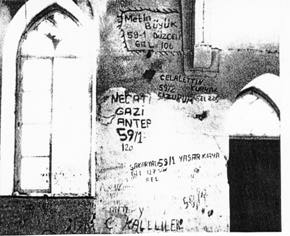
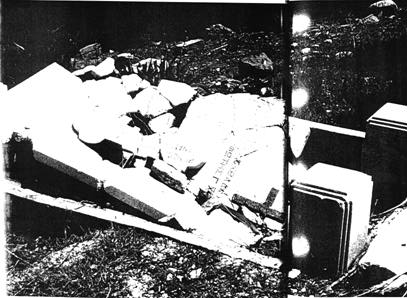

During the first days of the invasion,many civilians sought
sanctuary in churches. They two were forced however to take the
road to where they would be refugees.
The empty, unprotected churches had only one element that could protect them: their sanctity. They were not however respected. On the contrary, they became the the target of the destructive mania of the conquerors. A mania that in certain cases, leaves the observer speechless as it exists all limits or logic.
The forms which destruction takes are diverse : smashing up icons and other holy objects, scratching or other form of damage to icons and frescoes, theft, looting, pillage of churges. Visitors have testified that they found in churches, litters, beer bottles, human and animal excrement, smashed up icons and utensils.
From time to time the destruction and illicit dealings in
antiquities in the occupied part of Cyprus is noted by the
international press. It is mentioned that the markets of antiquities
in the occupied area as well as in Istanbul, Munich, Basle, Zurich,
Lyon, London and elsewhere are flooded by Cypriot antiquities. In
several cases the objects sold do not come from museums or
collections.They are the product of illicit digs in the occupied area
of Cyprus.
The problem of grave-digging and the illegal excavations pre- occupied the authorities of the Republic in the past, during the period 1964-1974. In the course of those years, a part of the Republic evaded the control of the legal authorities. Turkish Cypriot extremists, together with Turkish military personnel who had entered the island illegally had created enclaves and obstructed entry to them.
As a result of this situation, grave-digging, illegal excavations and smuggling of antiquities flourished within the Turkish enclaves.
The situation deteriorated further after the Turkish invasion and occupation of 37% of Cyprus' territory. The illegality took advantage of the tolerance, encouragement, or even, the participation of the regime's ''authorities'' and of the occupation troops. The finds which originate from the activity of the grave- diggers and illicit dealers in antiquities are sold either in the black market or in known ''antique shops'' in the occupied part of the island. The most important of these take the road to the world markets .
Rauf Denktash himself donated twenty ancient objects to the University of Virginia in 1982. After demarches by the Cyprus Government the beneficiaries returned the objects in order to salvage the University's prestige. Only two objects were returned to the legitimate owner, the Republic of Cyprus. The rest were returned to Mr. Denktash with the justification that ''there was no certification as to their exact origin''.
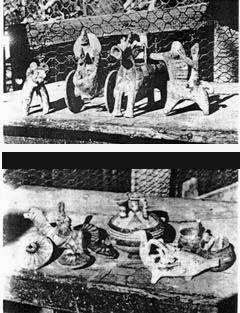
The illegal digs in Famagusta
"Illegal digs are being made in all districts. For example, in Kyrenia, in Ayios Epiktitos, in Nicosia, and in the hills beyond Krini. But, Famagusta is the most suitable for illegal digs. Illegal digs virtually cover the whole district. In this district the first settlements were established and since ancient times they had maintained their historical importance.
Illegal digs in the Karpass start from the cliff in the east, from the small islets in the sea, and from the caves of Galinoporni, and extend to the north-west of the Karpass, to Eptakomi, Ovogoros, Galatia and Ardhana".
''Perishing Cyprus'', in ''Olay'', 1 7.5. 1982.
The obliteration of every testimony as to the Greek and
Christian civilization of Cyprus constitutes one leg of the effort to
change the character of Cyprus. With other co-ordinated actions
the conquerors seek to Turkify the island: they have given Turkish
names to towns, villages and regions, they import en masse settler
colonists from Anatolia, they falsify and forge the history and the
cultural character of the occupied part of Cyprus.
Towns, villages and toponyms in Cyprus take their name from
mythical persons and events out of the depths of history. Kyrenia,
Lapithos, Salamina, Paphos, Soli, Amathus and countless other
sites on the island have been founded or took their name from
heroes of the Trojan war or from famous persons of the ancient
Hellenic world, like Praxandros, Teucer, Agapinor, Kipheas, Solon
Nomothetes and many other. In many cases we have names of
saints or names connected with traditions, myths, legends and
various events of life on the island.
Through the ages, for thousands of years, these names have survived. Foreign conquerors respected tradition and did not engage in any change of names. Among the conquerors, the Ottoman state, during the three centuries of its domination over Cyprus, did not change the situation.
Since 1974, the conqueror introduced a new "order''. In order for him to claim that Kyrenia and Kythrea, Morphou and Karavas, Lapithos, Ayios Vassilios, Rizokarpasso and countless other settlements are Turkish, it was imperative to have strong ''arguments''. All settlements were given new names, Turkish ones, while the old ones were wiped off the face of the map.
Using this method, Kiphea's Kyrenia became Girne, Hitrons Kythrea-Degkirmenlik, Praxandros' Lapithos was named Lapta, Morphou became Guzelyurt, Ayia Erini-Akdeniz, Ayios Amvrossios-Ecentepe, Ayios Georgios-Karaoglanoglu etc. There is no longer a connection between the new name and the age-long history and tradition of the place; all evidence was uprooted, having the fate that the invader inflicted upon the indigenous Greek population of the island.
The changing of names extends also to toponyms while the effort for Turkification is completed by the altering of all the signs in towns and villages, roads, shops, ''public'' buildings and elsewhere. The adoption of Turkish names was promoted with maps which are printed in Turkey by the occupation troops and the Denktash regime. On the maps, the only thing that has remained unaltered is the shape of the island, marked by the line of division, the line imposed by the Turkish Attila.
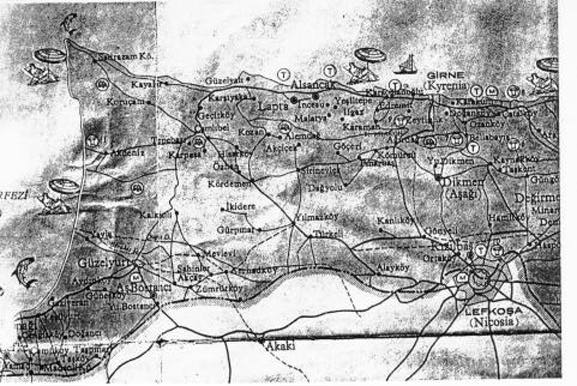
The imposition of division with the Attila line had as a result
the creation of a new situation as regards the demographic
composition of the occupied area: the Greek population was
expelled to the south and its place was taken by the Turkish
Cypriots who were obliged by their leadership to settle in the
occupied area.
For the consolidation of her plans Turkey maintains over 30,000 troops in Cyprus while her position is strengthened by the massive importation of colonist settlers from Anatolia. The selection of the region of origin of the settlers might not be incidental. It concerns the most backward Turkish region, both socially a nd culturally.
The importation of settlers to Cyprus began immediately after the Turkish invasion. The ''need'' for seasonal workers was used then as a pretext. These workers were supposed to help in the "collection of fruit'' from the orchards the conqueror had captured. Thousands of Turks flocked to the island while the regime offered to them ''Cypriot citizenship''.
The old Turkish claim has also been put forward that the settlers were, supposedly, Turkish Cypriots who emigrated to Turkey and elsewhere, and who consequently had the right to return .
"The seasonal workers'' today number about 80,000 and have come permanent inhabitants of the island with 'full rights', granted by Mr. Denktash and the Turkish army of occupation. Their presence in occupied Cyprus has caused friction and, in some cases, conflicts with the Turkish Cypriots, with whom they differ substantially in their social, cultural and other perceptions. The most important negative repercussion, however, for the Turkish Cypriots is the turning ineffective of their political will by the reactionary votes of the settlers.
With the introduction of these foreign elements the following consequences loom threatening on the horizon;
These anxieties become all the more pressing for the Turkish Cypriot community, which feels the increasing burden from the presence of settlers. A fair example is the reaction of the former Turkish Cypriot leader the late Fazil Kuchuk, who wrote that ''the entirely uneducated newly-brought Turks" must be sent back to Turkey ''before they convert Cyprus to a graveyard'' (Halkin Sesi, 25.5.1 978).
The Government of the Republic of Cyprus has pointed out on many occasions to international organizations the dangers for Cyprus and asked for an end to be put to colonization. The expulsion of the Greek element, and the settlement of colonists from the most backward districts of Turkey, constitutes the most disgraceful form of colonization of our age, an age which is characterized by the rapid course to complete de-colonization.
The procedure of wiping out the Greek and Christian presence
from occupied Cyprus is Turkey's doing and it has the sole aim of
serving her plans. Despite her claim that the Turkish invasion and
occupation of part of Cyprus took place in the name of the
''protection'' of the Turkish Cypriots, reality has proved to be quite
different. The scenario, in its broad outlines, appears revealing:
It is even more important to specify the contents of the term ''Turkification '':
Today, more than 80,000 settlers, colonists from Turkey, are established in the occupied part of Cyprus. Another 30,000 Turkish soldiers occupy this part while the Turkish Cypriot population, which does not exceed 100,000, wanes constantly as people are forced to emigrate.
Not only the Greeks but also the Turkish Cypriots do not have their place in the part of Cyprus occupied by Turkey.
The efforts of the Cyprus Government prove inadequate to save this heritage. The appeals, the buying back of stolen items by Cyprus, and other moves by the authorities did not prove enough to produce substantial results.
UNESCO bowed to some expediencies and buried a catapult report against Turkish action in Cyprus, burying with it a chance to save its own prestige.
In Cyprus the heritage of all and each one of us is being destroyed. At the same time, the inaction of the incompetent international bodies could help create the prerequisites for the repetition of the same crime in some other place.
It is an imperative need for all those who care for man and civilization, for all those who are interested in saving their heritage and the people of Cyprus, to act immediately and every direction using all means at their disposal in order to terminate th e pillage and destruction in the part of Cyprus occupied by the Turkish armed forces.
You too could help. In some way or other you could contribute to the salva
ging of the Greek and other heritage of Cyprus.
IT IS AFTER ALL YOUR OWN
HERITAGE.

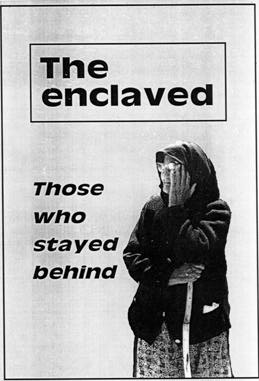

RETURN ![]() TO THE CYPRUS ACCESS PANEL
TO THE CYPRUS ACCESS PANEL